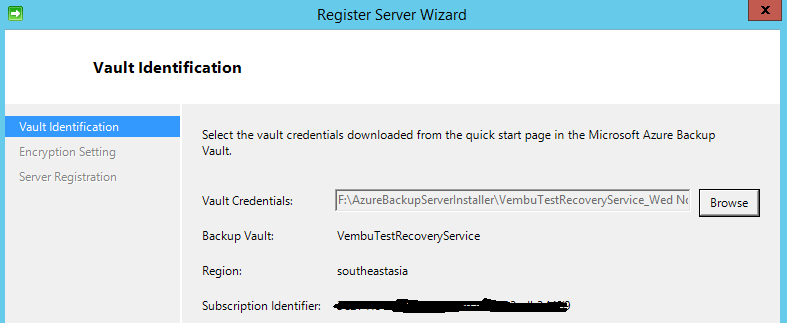Objective :
Preparing a backup plan for a production Hyper – V VM and Files & Folders existing in a Production server by creating Azure Recovery Services Vault & Installing Microsoft Azure Backup on an On-Premise server
Steps :
- Creating a Recovery Services Vault on Azure Portal
- Preparing Infrastructure : Installing Microsoft Azure Backup on a local server.
- Configuring backup for Hyper – V VM and Files & Folders from DPM installed agents.
Creating a Recovery Services Vault on Azure Portal.
Login to Azure Portal using your account. Click more services, and on filter type “recovery”, which will show the Recovery Services Vault. Add a new Recovery Services Vault. While creating a Recovery point, provide a Name, Subscription associated with that service, and the location you want to create the Service Vault. Choose nearby location for lesser latency.


After creating an Azure Recovery Service, Open that Recovery Service and Add Backup
This includes configuring backup goal, which asks where is your workload running ? Azure or On Premise. In our case, we are backing up On Premise VMs and File & Folders. So we will select ‘On Premise.’
Then, What do you want to backup ? Options are Files and Folders, Hyper – V Virtual machines, VMware Virtual machines, Microsoft SQL Server, Microsoft Exchange, Microsoft Exchange, System State and Bare Metal Recovery. Here we are selecting Hyper – V Virtual machines and Files & Folders.

Preparing Infrastructure
This phase includes Installing Microsoft Azure Backup server on Windows 2012 R2 physical server or a VM and registering the On Premise server to the vault by downloading vault credentials.
Download Azure Backup Server, on clicking “Download”, MicrosoftAzureInstaller package will be downloaded from the below URL
https://www.microsoft.com/en-us/download/details.aspx?id=49170
It will download MicrosoftAzureInstaller ( One EXE and 5 Bin files Total Szie 3.2 Gb ). After download, we need to put all files in a directory, execute the Installer with “Run as an Administrator” option.
Make sure that the Microsoft Azure Backup server is joined in your domain and meets all the prerequisites mentioned. Login under domain admin user account to proceed the Azure Backup installation. During installation, installer will check the prerequisites and install Microsoft SQL Server 2014 as backend. Typically DPM is installed on the server, and discovers all machines, desktops and laptops joined in the domain. While installing Microsoft Azure Recovery agent, Vault identification process is done by providing the vault credential file, generated on the Azure portal when configuring backup job.
Post installation you will find two desktop icons, Microsoft Azure Backup Server and Microsoft Azure Backup Management shell. Open Microsoft Azure BackupServer (run as administrator).

Installs Windows SQL server 2014 for database.

Runs SQL server service and SQL Server agent service with password.If you are connected through a proxy server, configure proxy-settings for connecting On Premise Azure backup server to Azure Vault. Provide downloaded vault credential from Azure Portal Azure recovery service, and register your Azure Backup server.

Provide encryption setting. This encryption will be set for all backup created on Azure Backup server. User need to keep the encryption file safely, and on recovery it will be used. Alternatively user can provide a passphrase manually.

Once the installation is completed, a desktop icon created for Microsoft Azure backup and powershell short created. Open the Microsoft Azure Backup application, there you will see three categories Agents, Disk and Online. And five tabs Monitoring, Protection, Recovery, Reporting and Management. Before configuring backup, user has to add disks for storage pool.

Provide a separate disk, and add that disk to Storage Pool. Application will change the disk Basic to Dynamic. Then include your backup agents to configure backup. Azure Backup server will install agent on these machines, and communicate the agent installed server. Once done, you can see the unprotected agent count under Agents. Under Online you can see registration status as “Registered” showing that the Azure Backup server is registered successfully with Azure Recovery Service Vault.

Configuring backup for Hyper – V VM and Files & Folders on DPM agent installed machines.
After installing DPM agent, these machines become members, and are available for data protection to choose Hyper – V VM and Files & Folders.

User has to create Protection group for his data to protect each backup. Here two Protection Groups created for Files and Folders backup available in a drive and a Hyper-V VM backup.
Below are the screenshots depicting the creation of backup and subsequent steps.








Conclusion :
We just had a comprehensive walkthrough for creating backup plan on DPM installed agents to configure its data from a domain based centralised Windows Azure backup server thus providing backup solution on-premise and online. The entire process might require several steps to complete either on Azure portal side, and on preparing local infrastructure and registering vault. Once all done carefully, creating multiple backup on DPM agents is simple and easy to monitor.
Sources :
Installing Windows Azure Backup Server and configuring Recovery services vault.
https://docs.microsoft.com/en-us/azure/backup/backup-azure-microsoft-azure-backup

